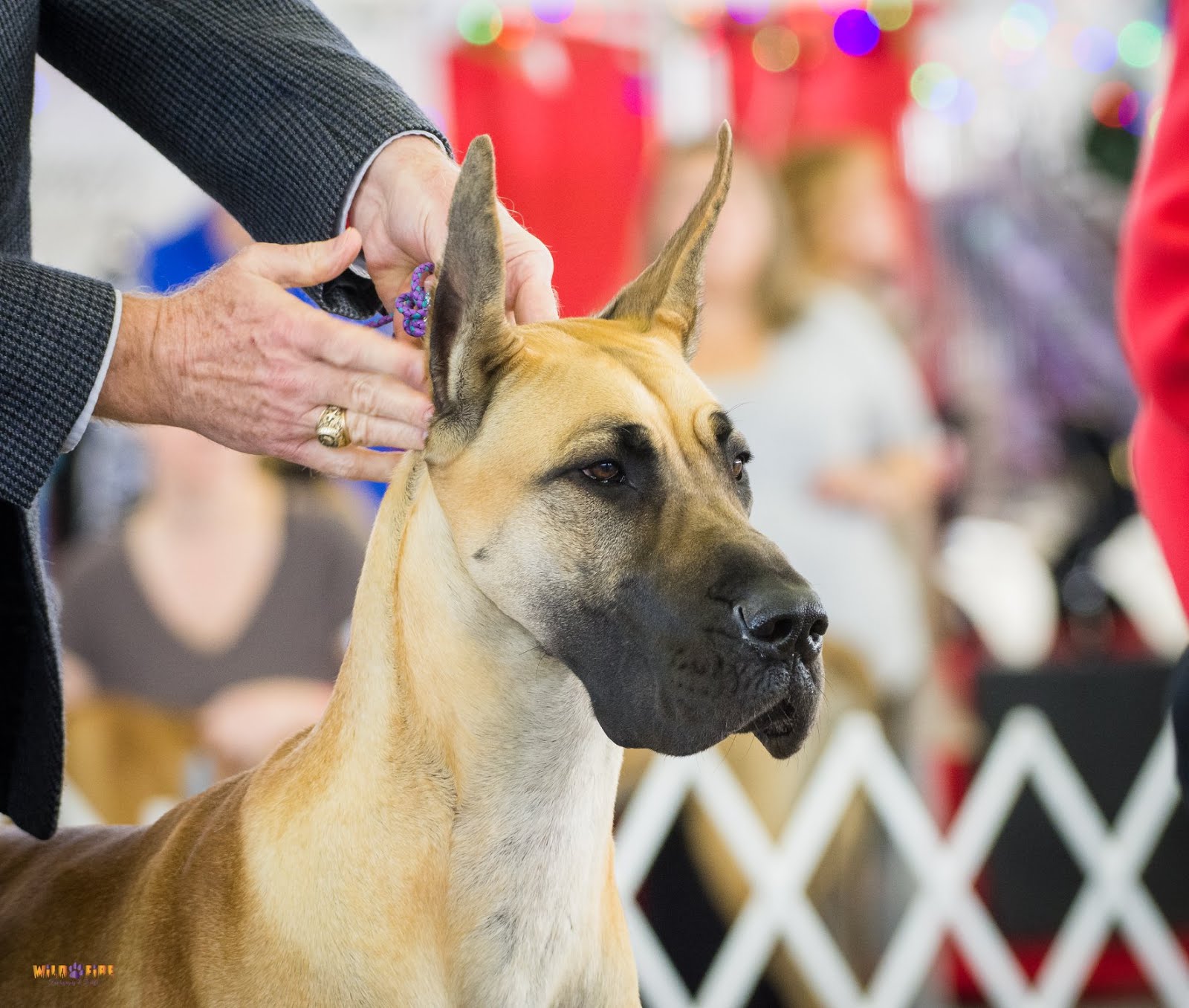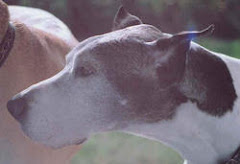Tuesday, September 30, 2008
Fighting Breed-Specific Legislation
And misguided it is. Yes, of course there are certain types of dogs who are more dangerous than others... large dogs for instance do usually cause more damage when they attack than small dogs do, because they are stronger. Adolescent, intact dogs are involved in more attacks on humans than puppies or old dogs, for the same reasons (youthful strength and energy, lack of life experience and raging hormones, combined with a lack of discipline) that adolescent and young adult men commit more violent crime than children or older adults. The most dangerous dogs of all, of course, are those owned by people who WANT to have a dangerous dog but are too irresponsible to be willing or able to properly manage their dogs.
But a particular breed being more dangerous? The only way to determine if a particular breed really IS more dangerous than others - based on reports of attacks on humans - is if you know the number of dogs of all the different breeds or mixes that are in a community. Then you could figure the percentage of dogs of each breed or type that are involved in serious attacks each year.
An article on dog bite prevention on the Centers for Disease Control web site states: "A CDC study on fatal dog bites lists the breeds involved in fatal attacks over 20 years (Breeds of dogs involved in fatal human attacks in the United States between 1979 and 1998). It does not identify specific breeds that are most likely to bite or kill, [emphasis mine -B] and thus is not appropriate for policy-making decisions related to the topic. Each year, 4.7 million Americans are bitten by dogs. These bites result in approximately 16 fatalities; about 0.0002 percent of the total number of people bitten. These relatively few fatalities offer the only available information about breeds involved in dog bites. There is currently no accurate way to identify the number of dogs of a particular breed, and consequently no measure to determine which breeds are more likely to bite or kill."
A commonly given example of this is that if a study indicates that there are five bites by golden retrievers and 10 bites by pit bulls, but there are 100 retrievers in the community and 500 pit bulls, then statistically the retrievers are the breed more likely to bite.
There are many many articles on the Internet and many books out now about this. A great article I just found is on the Caveat blog. Please go read it.
Why do I care about this so much? After all, I don't own a pit bull. I care mostly because BSL is just unfair, and WRONG, and unAmerican in the most essential way possible - it is absolutely and unashamedly willing to punish the majority of innocent pet owners in order to catch a few guilty parties.
And, of course, I also care because I'm scared. I know that all it would take would be for the media to decide that Great Danes are DANGEROUS and then my dogs would be next on the chopping block. Despite their having never done anything wrong.
And that is something I cannot even bear to think about.
Saturday, September 27, 2008
Breeding for Fun and Profit
A recent comment brought this topic to mind - thanks Abz! I think this is something that all owners of purebred dogs encounter at some point, but since some dogs attract more attention than others some of us run into it more than most. I'm talking about when you're out in public with your dog, and someone walks up to you and says something like "I've got a Great Dane [or whatever breed you have] too!! I've been looking to breed my dog - would you consider breeding your dog to mine?" Or words to that effect. So what do you say? What should you say? You can of course just say "No" or "Sorry, my girl is spayed". You could lie and say that your intact male has had a vasectomy (don't laugh - that procedure IS done on dogs, and may be a good alternative for sterilizing large or giant breed dogs before they are mature) (more on that later). Ideally however, this sort of situation can be used as an educational opportunity. True, much of the time - probably most of time - your words will fall on deaf ears. But if you can educate even 1 out of 10, that's a good thing. And you never know when you may be planting seeds of doubt in one or more of those other 9. You can talk about all the big reasons that they shouldn't breed their dog - especially if they have thoughts of creating the latest new "designer" mix. How difficult it can be to find really good homes. How many dogs of this breed turn up in shelters and rescues every year, and how likely it is - ESPECIALLY if the pups aren't registered purebreds - that their pups will also wind up in a shelter or rescue. However, you will probably see that their eyes start to glaze over as soon as you start talking about "The Big Picture". So make it personal. Figure out the motivation of the wanna-be breeder and address that, specifically. The motivation is usually either sentiment or profit. Is it sentiment? They think their dog is absolutely the greatest thing EVER and want to have another just like him/her? Or "all our friends want a pup out of our dog"? These can actually be the most difficult to talk out of breeding their dog. You can tell them that siblings are usually more similar to one another than parents are to offspring, so if they want another dog like the one they've got the best thing to do might be to go back to the breeder and get a sibling or half sibling. As for friends wanting a puppy - the same recommendation would hold true. Getting a sibling to your dog will be more likely to be similar to your dog than a puppy from it would be. But also tell them that friends who want a puppy have a way of evaporating once the litter is actually here. Maybe they've lost a job, or are having to move. Maybe they didn't wait, and got another puppy already somewhere else. Or maybe they've just changed their mind. And what if you've got, say, 4 friends who want a puppy but you have a litter of 10? Appeal to their sentiment, to their love for their dog - they wouldn't want to see any of their dog's babies in a shelter if something like that happened and they couldn't find homes for all the pups, would they? If you can tell you aren't making an impression with this argument, the next best thing you can do is talk about health. Start with keeping their own dog safe - males can catch venereal diseases, and can be seriously injured by a female who decides she's not "in the mood" or just takes a dislike to the guy. And of course, there is a whole list of awful things that can happen to the female. If the breeder isn't well informed and knows what signs of trouble to watch for, tragedy can strike and you can lose not only all the puppies but the mother too. If they still want to breed their dog, they will want to be sure they produce healthy puppies of course! Especially if all their friends get one - imagine the trouble if you sold puppies to all your friends and the pups turn out to have some sort of genetic disorder that crops up in a few years. You can talk to them about health testing, to try to prevent this sort of disaster. Sometimes once they understand all the possible health issues it will give them pause, and start them re-thinking the whole "Oh boy, let's have puppies" scenario. Explain that Brucellosis is a nasty venereal disease that CAN be picked up in dog parks and other places where dogs congregate - so even if both dogs are virgins they still need to be tested for it. Hip X-rays are necessary to rule out hip dysplasia with almost all breeds. Many breeds have heart issues and need cardiac screenings. There are other tests that are recommended for various breeds of dog - you can check the parent club web site (that will usually be The [insert breed name] Club of America or something similar) or the web site for the Orthopedic Foundation for Animals to see what is recommended for any particular breed. For Great Danes, the recommendation - at minimum - is to check hips, heart, eyes and thyroid. But what if the motivation is making a few bucks? These people can sometimes actually be easier to dissuade. Because the truth is, if you do the health testing you SHOULD do, and provide all the care that the mother and the pups will need until the pups are 8 weeks old, it's damn hard to break even, much less make a profit. You can start by explaining the same health testing recommendations. OFA hip screenings; thyroid, heart and eye screenings; and a Brucellosis test can all easily come to $500 or more. $250 or $300 minimum if you get a deal from your vet, and get some screenings done at dog shows where they often offer a discount on these things. (They can do screenings at a discount at shows because the kennel club hosting the show will get a specialist to come in for a whole day, and he/she will sit there and check eyes or hearts or whatever all day long.) The health tests need to be done on both parents, obviously. And for the stud owner, the cost of the health testing will take a whopping chunk out of the stud fee. For the bitch owner, the expenses are just beginning. You'll have the stud fee - this can range from half the cost of one puppy (typical with unproven sires) to the whole cost of a puppy, or even the pick of the litter. Or more. If the mother has trouble whelping (giving birth) she may need a C-section. This is an expensive surgery anyway - add to the cost the fact that it almost ALWAYS happens in the middle of the night requiring a visit to an expensive emergency clinic, and that C-section surgery can easily cost $1000 or more for a large dog. But the real kicker - especially with large or giant breed puppies - is FOOD!! With a large litter, the mother may double or even triple her food intake for the first 2 or 3 weeks until the pups start eating some mush on their own. And it is absolutely shocking how much puppies will eat from the time they are 3 or 4 weeks old, until you sell them at 8 weeks. By the time they are 6 or 7 weeks old, each PUPPY will be eating at least as much as a sedentary adult dog. This is why many uneducated breeders - whether they produced the litter accidentally, or did so with the thought of making some money - become absolutely desperate to get rid of the pups. Every day they keep the little monsters, they see their profit margin shrinking and going into the red. This is also why some breeders try to sell pups at 5 or 6 weeks old - fortunately this is actually illegal in many places. Even though pups at that age are usually eating "solid" food they still need their mother and littermates to teach them manners, bite inhibition, how to relate normally with other dogs, and other vital life lessons. So NEVER EVER take home a pup who is less than 7 weeks old, MINIMUM!! Just as an example of the costs involved, here's the breakdown from our last litter. I am NOT including show expenses in this, since showing is a hobby for us and we do it whether or not we're planning to breed the dog someday. But on the other hand, we WOULDN'T breed a dog who wasn't good enough to at least be competitive in the show/obedience/agility ring. And, of course, "show quality" puppies are worth more (or should be worth more, keep reading) than pups from parents who haven't been shown or can't be shown. So if I really wanted to horrify you, I could include those expenses! Ha! - Health testing $500 OFA, thyroid, heart, eye, Brucellosis - Breeding costs $750 Progesterone tests (to pinpoint ovulation) and stud fee - Whelping costs $1250 Whelpwise service and C-section I need to write a post on Whelpwise, they are AMAZING and are the main reason ALL of Kinsey's puppies arrived safe and healthy. And as for the C-section, fortunately this was done by my trusted regular vet, and not after hours - Extra dog food $500 This is for the lactating bitch and 5 growing pups to 9 weeks of age. This is a pure guess, and is probably REALLY low. Honestly I have no idea how much it was. It was easily double the normal food bill for our crew for those 2 months or so. We didn't sell Gus until he was 4 or 5 months old, so if you include HIS extra food bill, it would be a lot more than that!! - Deworming, puppy exams and vaccinations $300 - Ear crops $1000 Obviously this is optional, and controversial. But very common with show puppies. - Taking 2+ weeks unpaid leave from work $1300 Theoretically this is optional too. There are LOTS of very responsible breeders who don't (because they can't) take off more than a day or two when they have a litter. And of course, someone who works from home or at home wouldn't have a pay cut for being there. At the time I was just working part time, but I couldn't bear to NOT stay home with them. So I did! I've forgotten lots of things, and had to guess on others. I actually DID keep excellent records but a disastrous and total hard drive crash about a year after the pups were born lost all of that. It's a hard lesson: MAKE BACK UPS! But the total of the expenses above is $5600. Now this may shock some of you, but with many breeds an actual, "bona fide" show quality puppy - i.e. one or both parents are actually show Champions or at least have show points, and the puppy gives every indication of maturing into an individual who will also be able to win in shows - actually isn't that expensive. No more expensive than puppies sold at pet stores who come from puppy mills, or puppies sold on anonymous web sites from kennels who don't show their dogs, and may or may not be puppy mills. It's more DIFFICULT to get a puppy from a reputable breeder because they CARE about their pups, but that's a different story. But the truth is that supply and demand control the price of show puppies just like everything else. In our area, fawn and brindle show pups sold at that time for about $1200. But that still sounds like a lot, right? So, sale of 3 pups: $3600 Our net loss was at least $2000. All of a sudden, that $1200 for a puppy doesn't sound like so much, does it? And bear in mind that - other than needing a C-section - this was an "easy" litter. The mother had no health problems during pregnancy, and all the pups not only survived but were robustly healthy.
But so many things can go wrong, and if your goal is making a profit you can easily wind up in the hole, financially. If the mother gets an infection at some point, or if you have a sick puppy you can easily spend additional hundreds or thousands of dollars in veterinary care. Worst case scenario is when most or all of the pups die - maybe the mother too - and you have absolutely nothing to show for the experience.
In our case, if we'd sold all 5 pups we would have made a "profit" of $400. For several months of hard work and sleepless nights. Woo-hoo. But of course the whole plan for us all along was to keep at least one pup for ourselves. Sure, we could have made more if Kinsey had had more than 5 pups that we could have sold, or if she hadn't needed a C-section... if, if, if. It IS possible to break even or even make a decent profit on a litter WITHOUT cutting corners if you're lucky. That is, if you don't pay yourself for your time - raising a litter properly is unbelievably time consuming and if we "paid" ourselves for that time there would never be a way to break even. Of course, we don't look at it that way. We got 5 wonderful, wonderful dogs from this litter. They just turned 3. Three of them have finished their AKC Championships, and one only needs her major points. Two of them have obedience titles. Two are in agility training and will start showing in agility soon. We've made some wonderful new friends because of them. And ALL of them are sweet, and stable, and funny and smart and beautiful and totally loved by their owners. So by all the standards that really matter, we hit the frickin' MULTI STATE LOTTO JACKPOT with this litter. And we'll try to do it again as soon as we can afford to :-) But anyway, back to the original topic - I hope this gives you all some talking points the next time someone approaches you and asks you about breeding their dog to your dog. Assuming you want to expend your time and energy on what may be a waste of your time, what will YOU say?
Thursday, September 18, 2008
Poop happens!
For mild cases, sometimes the best remedy is to skip a meal. Let the GI tract rest and recuperate. Don't do this with puppies under 6 months, elderly dogs, dogs with chronic severe illness, or pregnant/lactating bitches.
Adding plain canned pumpkin to the dog's food (not pumpkin pie filling which contains spices and sugar) can help - the fiber tends to "clean out" the digestive tract and may help sweep away irritants. A plain baked or boiled potato often works to settle an upset system. The latest and greatest remedy is Activia yogurt - you can find this plain, in large tubs.
If the diarrhea is severe, if it persists more than a day or two despite the above remedies, or if the dog seems to not feel well - take him/her to your vet! Something serious may be going on. Diarrhea in puppies and elderly dogs is always a cause for immediate action - they can become dehydrated quickly and this can be life threatening situation.
As for clean up in your yard when Fido has the cow pattie poops, try sprinkling some clumping cat litter on the mess. After a few minutes you should be able to pick most of it up. While just using the hose and washing it into the ground is tempting, make sure your dog doesn't have any parasites before you do this. You don't want to infest your yard!!
Speaking of poop pick up, Dr. Khuly at Dolittler has an interesting article today. She's always interesting, and has one of my favorite pet blogs.
Tuesday, September 16, 2008
Great Dane Fun Day!
-----------------
You (and your Dane!) are invited to a Great Dane Fun Day! It is this Sunday, at Bob Woodruff park in Plano. This is not only an opportunity to get out with your dog or puppy and have a fun day, but also you'll have a chance to find out about and try out various fun events with your dog!
We'll have information about all sorts of Dane topics and health issues; demonstrations and run throughs for all levels of Obedience; demonstrations and practice for Rally obedience; a CGC test; a conformation handling seminar; a conformation match; a great Raffle of Dane-related items; and last but not least GREAT FOOD!!
**Your Dane does NOT have to be registered to participate!**
The flyer info is copied below - feel free to print it out and distribute it if you wish. Please feel free to cross post this message to anyone interested in Great Danes.
We hope to see you all there!! If you have any questions, please let me know.
Barb
--------------------------
Great Dane Fun Day
Sunday, September 21, 2008
9:00am
Sponsored by the Great Dane Club of Greater Dallas
Are you interested in learning about fun activities and events you can enjoy with your Dane? Do you have a puppy that you want to socialize? Or do you just want to come out with your Dane, meet other Dane lovers and their dogs, and have a GREAT Dane Day!!
We are having:
- An Obedience Demo and Show & Go
- A Rally Obedience Demo & Practice
- A Canine Good Citizen Test (For the CGC only, dogs must be 6 months old, and must have proof of Rabies vaccination.)
- A Handling seminar by Steve Arnold
- A Sanctioned B AKC Conformation Match (Great Danes Only)
- A Pot Luck Picnic following the Match
- A RAFFLE with Dane-appropriate gifts!!
Community Park Bob Woodruff Park
2601 San Gabriel Drive
Plano TX, 75074
Directions to the Fun Day TX 75 to E Parker Rd (east)
South (right) on San Gabriel to Park
Conformation Match entries: $5.00 (entries taken day of Match. Match starts at 11:00)
CGC Test: $5.00 (must have current Rabies vaccination certificate with you day of test, and the dog must be at least 6 months old)
Come and enjoy all the Great Dane Activities!!!
Thursday, September 04, 2008
Teddy the cuddly
But that's the way a lot of Danes are - they really, REALLY like to be near their people. That doesn't necessarily mean they have to sleep in your bed - in fact, I'll cold heartedly make Teddy get off the bed when I go in there. (I'm such a bitch!)
But they DO need to feel that they're part of the family. If you've ever tried to buy a Dane puppy from a reputable breeder, or tried to adopt one from a reputable Rescue and wondered "why am I getting the third degree here?" - that's why. They know what it takes to keep a Dane healthy and happy, and go to great lengths to be sure that they get put with families who will not only love the dog, but really spend a lot of time with it.
A lonely Dane is a neurotic Dane!








